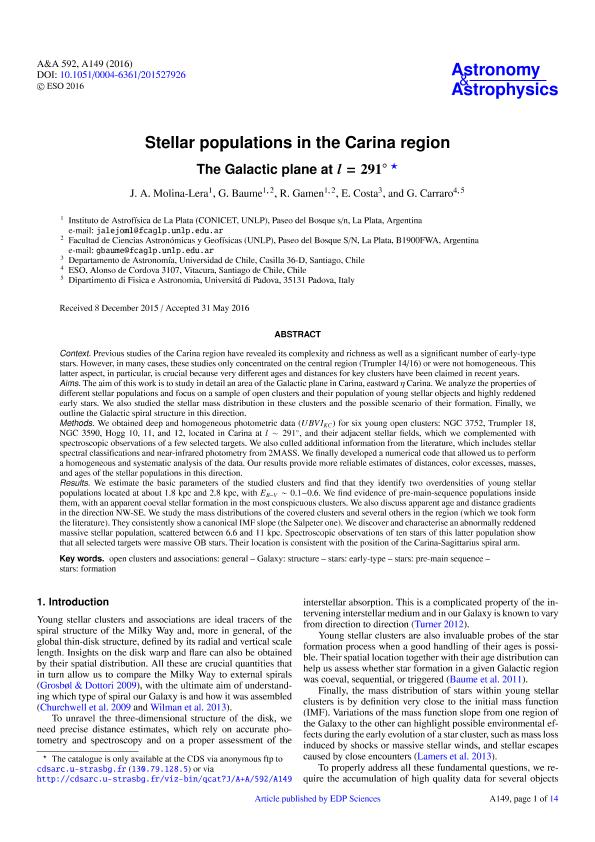Mostrar el registro sencillo del ítem
dc.contributor.author
Molina Lera, José Alejo

dc.contributor.author
Baume, Gustavo Luis

dc.contributor.author
Gamen, Roberto Claudio

dc.contributor.author
Costa, E.
dc.contributor.author
Carraro, Giovanni

dc.date.available
2018-02-19T16:35:11Z
dc.date.issued
2016-08
dc.identifier.citation
Molina Lera, José Alejo; Baume, Gustavo Luis; Gamen, Roberto Claudio; Costa, E.; Carraro, Giovanni; Stellar populations in the Carina region : the Galactic plane at l = 291º; EDP Sciences; Astronomy and Astrophysics; 592; 8-2016; 149-163
dc.identifier.issn
0004-6361
dc.identifier.uri
http://hdl.handle.net/11336/36717
dc.description.abstract
Context. Previous studies of the Carina region have revealed its complexity and richness as well as a significant number of early-type stars. However, in many cases, these studies only concentrated on the central region (Trumpler 14/16) or were not homogeneous. This latter aspect, in particular, is crucial because very different ages and distances for key clusters have been claimed in recent years. Aims. The aim of this work is to study in detail an area of the Galactic plane in Carina, eastward η Carina. We analyze the properties of different stellar populations and focus on a sample of open clusters and their population of young stellar objects and highly reddened early stars. We also studied the stellar mass distribution in these clusters and the possible scenario of their formation. Finally, we outline the Galactic spiral structure in this direction. Methods. We obtained deep and homogeneous photometric data (UBV IKC) for six young open clusters: NGC 3752, Trumpler 18, NGC 3590, Hogg 10, 11, and 12, located in Carina at l ∼ 291◦ , and their adjacent stellar fields, which we complemented with spectroscopic observations of a few selected targets. We also culled additional information from the literature, which includes stellar spectral classifications and near-infrared photometry from 2MASS. We finally developed a numerical code that allowed us to perform a homogeneous and systematic analysis of the data. Our results provide more reliable estimates of distances, color excesses, masses, and ages of the stellar populations in this direction. Results. We estimate the basic parameters of the studied clusters and find that they identify two overdensities of young stellar populations located at about 1.8 kpc and 2.8 kpc, with EB−V ∼ 0.1−0.6. We find evidence of pre-main-sequence populations inside them, with an apparent coeval stellar formation in the most conspicuous clusters. We also discuss apparent age and distance gradients in the direction NW-SE. We study the mass distributions of the covered clusters and several others in the region (which we took form the literature). They consistently show a canonical IMF slope (the Salpeter one). We discover and characterise an abnormally reddened massive stellar population, scattered between 6.6 and 11 kpc. Spectroscopic observations of ten stars of this latter population show that all selected targets were massive OB stars. Their location is consistent with the position of the Carina-Sagittarius spiral arm
dc.format
application/pdf
dc.language.iso
eng
dc.publisher
EDP Sciences

dc.rights
info:eu-repo/semantics/openAccess
dc.rights.uri
https://creativecommons.org/licenses/by-nc-sa/2.5/ar/
dc.subject
Open Clusters
dc.subject
Galaxy
dc.subject
Early Type Stars
dc.subject
Pre-Main Sequence (Estrellas)
dc.subject
Formation of Stars
dc.subject.classification
Astronomía

dc.subject.classification
Ciencias Físicas

dc.subject.classification
CIENCIAS NATURALES Y EXACTAS

dc.title
Stellar populations in the Carina region : the Galactic plane at l = 291º
dc.type
info:eu-repo/semantics/article
dc.type
info:ar-repo/semantics/artículo
dc.type
info:eu-repo/semantics/publishedVersion
dc.date.updated
2018-02-07T17:03:28Z
dc.journal.volume
592
dc.journal.pagination
149-163
dc.journal.pais
Francia

dc.journal.ciudad
Paris
dc.description.fil
Fil: Molina Lera, José Alejo. Consejo Nacional de Investigaciones Científicas y Técnicas. Centro Científico Tecnológico Conicet - La Plata. Instituto de Astrofísica La Plata. Universidad Nacional de La Plata. Facultad de Ciencias Astronómicas y Geofísicas. Instituto de Astrofísica la Plata; Argentina
dc.description.fil
Fil: Baume, Gustavo Luis. Universidad Nacional de la Plata. Facultad de Ciencias Astronómicas y Geofísicas; Argentina. Consejo Nacional de Investigaciones Científicas y Técnicas. Centro Científico Tecnológico Conicet - La Plata. Instituto de Astrofísica La Plata. Universidad Nacional de La Plata. Facultad de Ciencias Astronómicas y Geofísicas. Instituto de Astrofísica la Plata; Argentina
dc.description.fil
Fil: Gamen, Roberto Claudio. Universidad Nacional de la Plata. Facultad de Ciencias Astronómicas y Geofísicas; Argentina. Consejo Nacional de Investigaciones Científicas y Técnicas. Centro Científico Tecnológico Conicet - La Plata. Instituto de Astrofísica La Plata. Universidad Nacional de La Plata. Facultad de Ciencias Astronómicas y Geofísicas. Instituto de Astrofísica la Plata; Argentina
dc.description.fil
Fil: Costa, E.. Universidad de Chile; Chile
dc.description.fil
Fil: Carraro, Giovanni. Università di Padova; Italia
dc.journal.title
Astronomy and Astrophysics

dc.relation.alternativeid
info:eu-repo/semantics/altIdentifier/url/http://www.aanda.org/articles/aa/pdf/2016/08/aa27926-15.pdf
dc.relation.alternativeid
info:eu-repo/semantics/altIdentifier/doi/http://dx.doi.org/10.1051/0004-6361/201527926
Archivos asociados
